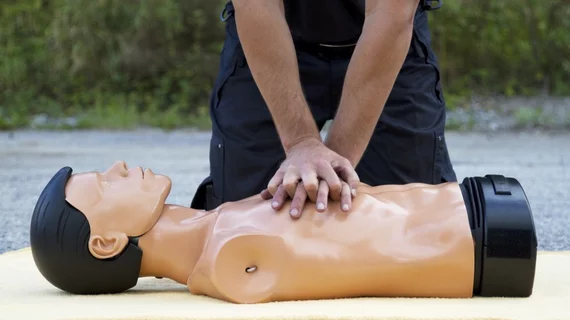Hands-only CPR doubles survival, boosts bystander intervention rates
The proportion of out-of-hospital cardiac arrest (OHCA) patients in Sweden who received bystander CPR increased by 27.4 percent over an 18-year period, according to a new study, with much of that growth attributed to the increased utilization of chest compression-only CPR.
That hands-only approach has increasingly been pushed as an alternative to standard CPR with chest compressions and rescue breaths, and Swedish guidelines were updated in 2010 to recommend compression-only CPR for both untrained bystanders and those unwilling to perform rescue breaths.
Gabriel Riva, MD, with Karolinska Institutet in Stockholm, and colleagues studied outcomes from more than 30,000 patients who had bystander-witnessed OHCA reported to a Swedish register from 2000 to 2017. The proportions of patients receiving any bystander CPR increased from 40.8 percent from 2000 to 2005, to 58.8 percent from 2006 to 2010, to 68.2 percent from 2011 to 2017.
While the number of patients receiving standard CPR stayed within a 10-percent-wide window during each of the periods, the proportion receiving compression-only CPR (CO-CPR) increased almost six-fold—from 5.4 percent to 14 percent to 30.1 percent, respectively.
Importantly, survival at least doubled with either CPR technique compared to no bystander CPR. In adjusted analysis, standard CPR was linked to 2.6 times the odds of 30-day survival while hands-only CPR was associated with 2.0 times the chance of survival.
“Barriers to the initiation of bystander CPR include fear of being incapable, causing harm, and infection,” Riva et al. wrote in Circulation. “CO-CPR is easier to perform for the bystander and could theoretically be associated with increased CPR rates. Our findings indicate that the endorsement of CO-CPR in CPR guidelines is associated with higher overall CPR rates, which may be linked with overall survival.”
The authors pointed out that when emergency medical services (EMS) response times were between 10 and 14 minutes, CO-CPR was no longer associated with higher survival, “suggesting that ventilation is crucial when EMS response times are prolonged.” However, neither type of bystander CPR was linked to better survival if EMS response time was longer than 14 minutes—a scenario which produced few survivors.
Nevertheless, the most important takeaway, according to the authors, is that any form of early CPR can be life-saving for cardiac arrest victims.
“CPR in its simplest form is just chest compressions,” Riva said in a press release. “Doing only chest compressions doubles the chance of survival, compared to doing nothing.”

